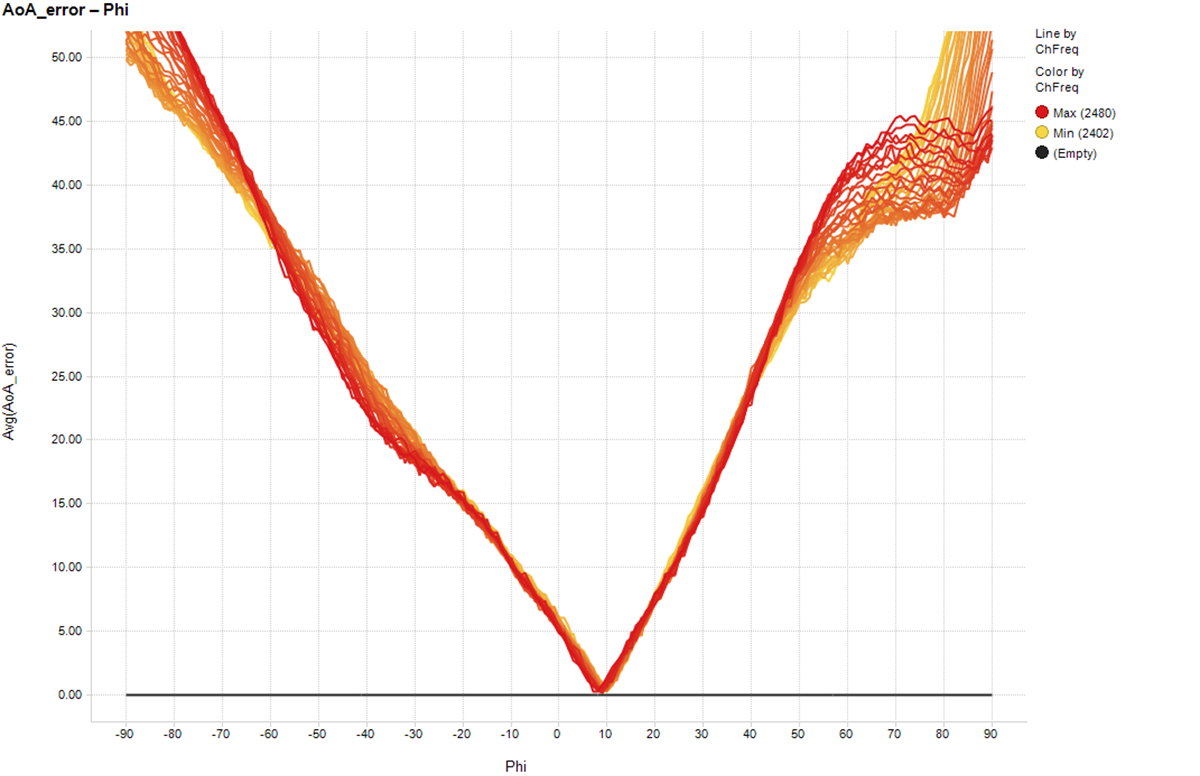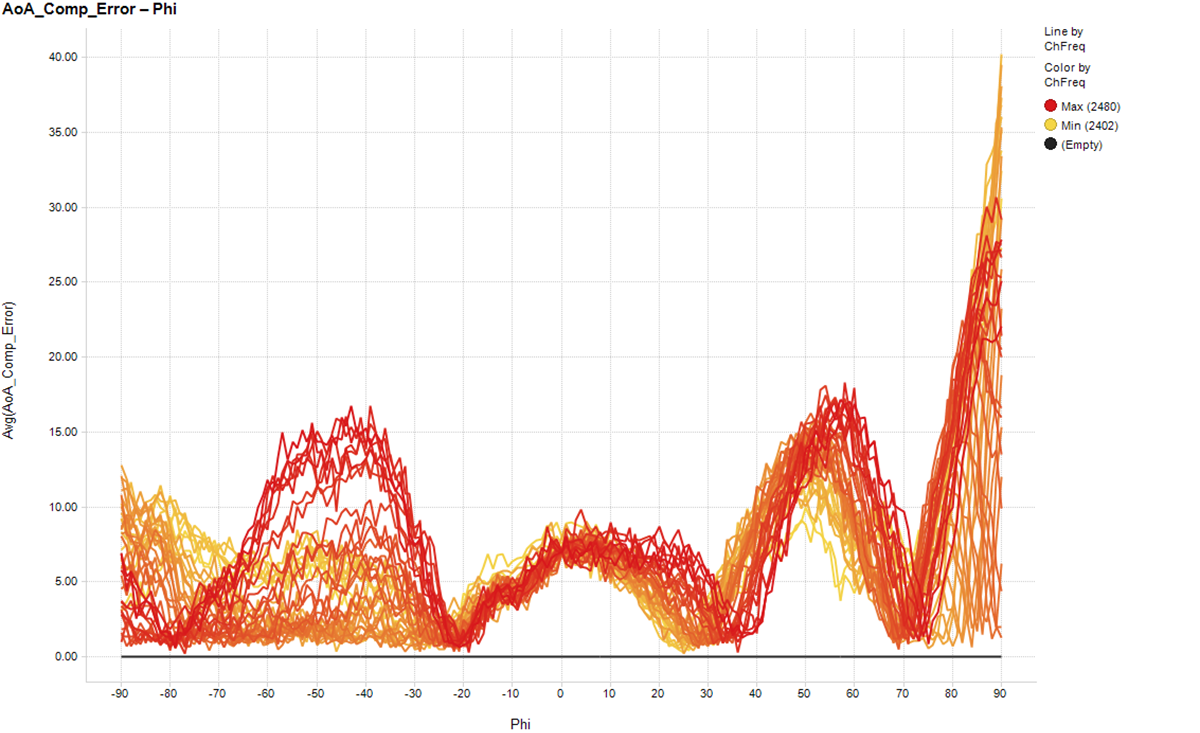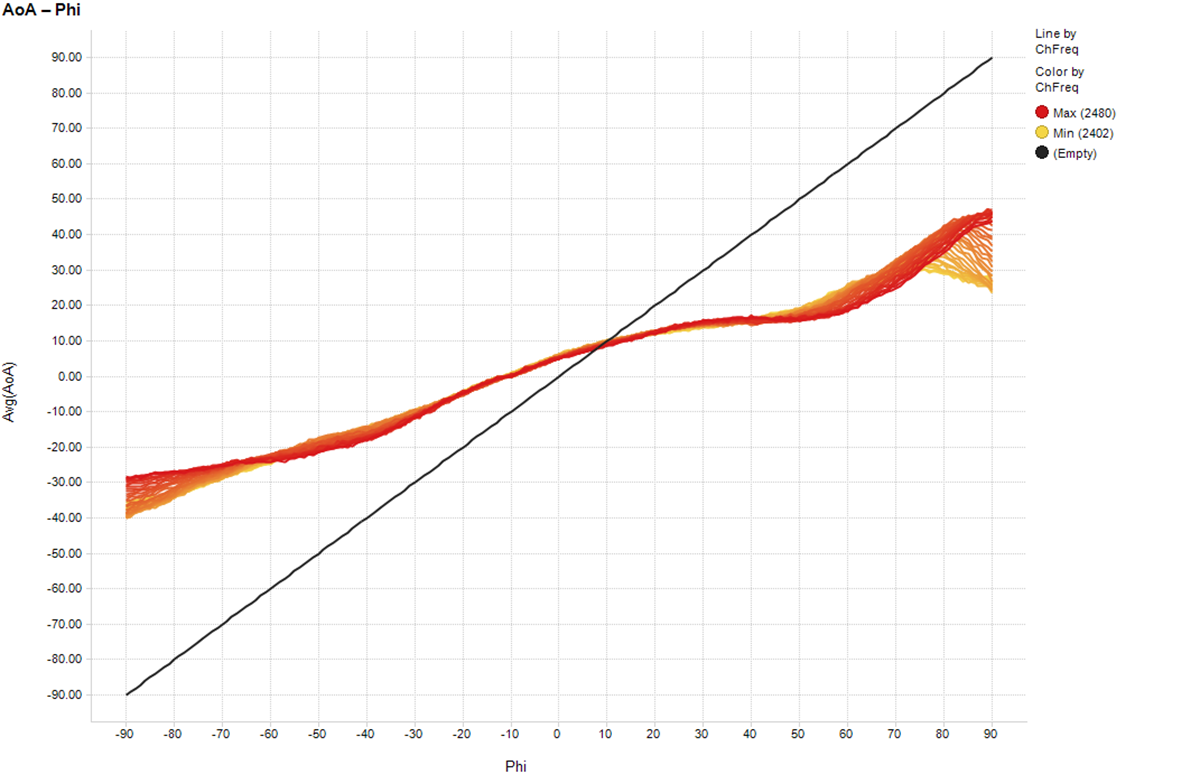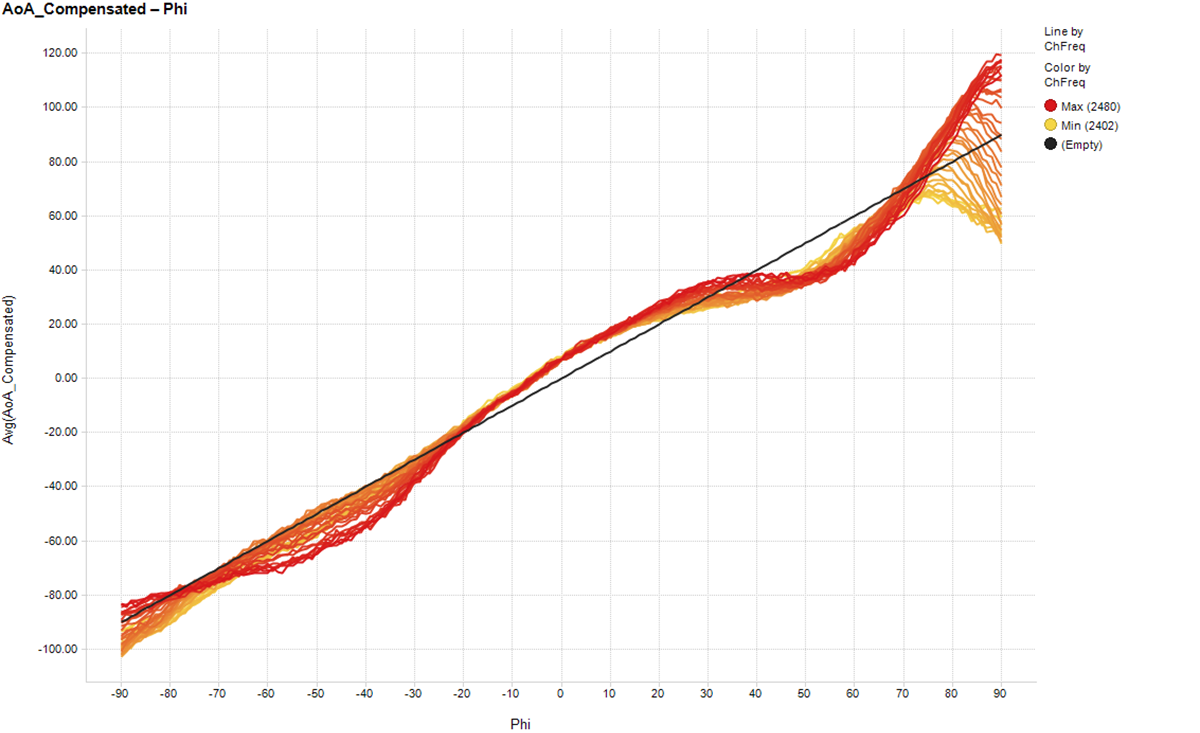TIDA029A july 2019 – june 2023 CC2640R2F-Q1 , CC2642R , CC2642R-Q1
- 1
- Bluetooth Angle of Arrival (AoA) Antenna Design
- Trademarks
- 1Introduction
- 2Angle of Arrival Antenna Design Considerations
- 3Dipole Antenna Array
- 4Calculating AoA From IQ Measurements
- 5References
- 6Revision History
4.2.3 PCB + RF Absorbing Material + Tin-Plated Copper Foil + Metal Compensated AoA
The PCB + RF absorbing material + tin-plated copper foil + metal hardware setup is the only hardware setup that the offset was not adjusted for AoA to equal zero when Phi equals 0. The results are not linear for the whole –90° to 90° range and to balance the error across the full angle range, the offset was set to have an error of 7° when Phi equals 0. Better compensation methods can be used to improve the results but in this paper, only basic best fit line linear compensation was implemented. Table 4-3 shows the gain and offset used for each frequency.
| Frequency (MHz) | Channel | Gain | Offset |
|---|---|---|---|
| 2402 | 37 | 2.44 | –2.55 |
| 2404 | 0 | 2.44 | –2.12 |
| 2406 | 1 | 2.44 | –2.87 |
| 2408 | 2 | 2.44 | –3.07 |
| 2410 | 3 | 2.44 | –3.16 |
| 2412 | 4 | 2.44 | –3.28 |
| 2414 | 5 | 2.44 | –3.22 |
| 2416 | 6 | 2.38 | –2.71 |
| 2418 | 7 | 2.38 | –2.92 |
| 2420 | 8 | 2.38 | –2.92 |
| 2422 | 9 | 2.38 | –2.21 |
| 2424 | 10 | 2.38 | –3.15 |
| 2426 | 38 | 2.38 | –2.55 |
| 2428 | 11 | 2.38 | –2.68 |
| 2430 | 12 | 2.38 | –3.11 |
| 2432 | 13 | 2.38 | –2.82 |
| 2434 | 14 | 2.38 | –2.74 |
| 2436 | 15 | 2.38 | –2.74 |
| 2438 | 16 | 2.38 | –2.66 |
| 2440 | 17 | 2.38 | –2.44 |
| 2442 | 18 | 2.38 | –2.37 |
| 2444 | 19 | 2.44 | –2.65 |
| 2446 | 20 | 2.44 | –2.37 |
| 2448 | 21 | 2.44 | –2.62 |
| 2450 | 22 | 2.44 | –2.5 |
| 2452 | 23 | 2.5 | –2.68 |
| 2454 | 24 | 2.5 | –2.35 |
| 2456 | 25 | 2.5 | –2.4 |
| 2458 | 26 | 2.5 | –2.62 |
| 2460 | 27 | 2.56 | –2.4 |
| 2462 | 28 | 2.56 | –2.33 |
| 2464 | 29 | 2.56 | –2.53 |
| 2466 | 30 | 2.63 | –2.66 |
| 2468 | 31 | 2.63 | –2.32 |
| 2470 | 32 | 2.7 | –2.37 |
| 2472 | 33 | 2.7 | –2.93 |
| 2474 | 34 | 2.7 | –2.72 |
| 2476 | 35 | 2.7 | –2.3 |
| 2478 | 36 | 2.7 | –2.3 |
| 2480 | 39 | 2.7 | –2.43 |
Figure 4-22 and Figure 4-23 show the difference in the uncompensated and compensated error.
 Figure 4-22 PCB + RF Absorbing
Material + Tin-Plated Copper Foil + Metal Uncompensated AoA Error
Figure 4-22 PCB + RF Absorbing
Material + Tin-Plated Copper Foil + Metal Uncompensated AoA Error Figure 4-23 PCB + RF Absorbing
Material + Tin-Plated Copper Foil + Metal Compensated AoA Error
Figure 4-23 PCB + RF Absorbing
Material + Tin-Plated Copper Foil + Metal Compensated AoA ErrorThe error is greatly improved with compensation. Depending on the frequency, this hardware setup shows less than 10° of error from –90° to 40° and 70° to 90°. There is considerable error from 40° to 65° for most frequencies. Better compensation methods could greatly improve this error while still maintaining the full range of ±90°. Figure 4-24 and Figure 4-25 show the uncompensated AoA vs compensated AoA.
 Figure 4-24 PCB + RF Absorbing
Material + Tin-Plated Copper Foil Uncompensated AoA Results Over all
Bluetooth Low Energy Channels
Figure 4-24 PCB + RF Absorbing
Material + Tin-Plated Copper Foil Uncompensated AoA Results Over all
Bluetooth Low Energy Channels Figure 4-25 PCB + RF Absorbing
Material + Tin-Plated Copper Foil + Metal Compensated AoA Results Over all
Bluetooth Low Energy Channels
Figure 4-25 PCB + RF Absorbing
Material + Tin-Plated Copper Foil + Metal Compensated AoA Results Over all
Bluetooth Low Energy Channels